Do you have a question about the Minolta VECTIS 40 and is the answer not in the manual?
Three print formats available: H, C, and P Print. Viewfinder frame adjusts.
Imprint date or preselected titles on prints for easy identification.
Prevents accidental reexposure of film using cassette indicators.
Allows rewinding and reloading film mid-roll, advancing to unexposed frame.
Choose the number of prints received from the lab before shooting.
Records lighting/exposure data on film for lab color correction.
Explanation of symbols used for proper and safe operation.
Illustrations of warning and prohibition symbols.
Important safety warnings regarding flash, sun, and handling.
Cautions for safe operation, preventing injury and damage.
Warnings about battery handling, explosion risk, and proper use.
Specific warnings for use near children or those with difficulty perceiving danger.
Potential accidents from lack of caution, like flash near eyes or strap use.
Guidelines for camera use in various temperatures and humidity.
Warning about magnetic fields affecting film data storage.
Troubleshooting steps for data panel errors and malfunctions.
Diagram and labels for viewfinder components.
Instructions on how to attach the camera strap.
How to check battery status and indicators.
Customizing the viewfinder for eyesight accuracy.
Explanation of VEI markings on film for exposure status.
Focus distance limits for C/H and P formats; shutter locks if too close.
Handling difficult autofocus scenes like bright areas or low contrast.
Ensures accurate focus by holding it on a subject outside the focus frame.
Automatic film rewind process after the last exposure.
Allows mid-roll film rewinding and reloading; notes on compatibility.
Situations where MRC feature may not work properly.
Recommendation to use certified Advanced Photo System photofinishers.
Information on flash charging, range, and ISO dependency.
Mode to reduce red-eye effect using short pre-flash bursts.
Flash fires regardless of lighting for fill light or shadow reduction.
Disables flash for twilight, distant subjects, or ambient light capture.
Standard point-and-shoot mode.
Optimizes settings for close-up photography.
Optimizes settings for portrait situations.
Provides balanced exposure for night portraits.
Optimized for landscape and scenic photos, day or night.
Choose the number of prints to receive from the lab before shooting.
Resets print quantity to zero for the next frame after shooting.
Records date/time on film's data-strip for photofinisher imprinting.
Procedure to select date format for front print imprinting.
Setting the camera's quartz clock and automatic calendar.
Selecting the display format for date and time information.
Preselecting titles for printing on the back of photos.
Titles displayed as codes; refer to Title List for details.
Changing or setting title codes in memory.
Procedure to select title code for back print imprinting.
Adding an additional title for the entire roll, imprinted on print backs.
Using focus hold for subjects not centered in the frame with remote control.
Procedure for replacing the battery in the remote control unit.
Film printed according to the format set when the picture was taken.
Date, time, and title printed on the back of the picture.
Lab compensates printing based on data recorded on magnetic strips.
Film returned in original cassette for protection and organization.
Numbered image of each frame included with returned order.
Images captured in H format; reprints can be ordered in any of three formats.
Instructions for cleaning AF/AE windows, camera body, and lens.
Guidelines for storing the camera in a cool, dry, well-ventilated area.
Check camera operation and take test photographs.
Contact dealer or Minolta Service Facility for questions or repairs.
Three print formats available: H, C, and P Print. Viewfinder frame adjusts.
Imprint date or preselected titles on prints for easy identification.
Prevents accidental reexposure of film using cassette indicators.
Allows rewinding and reloading film mid-roll, advancing to unexposed frame.
Choose the number of prints received from the lab before shooting.
Records lighting/exposure data on film for lab color correction.
Explanation of symbols used for proper and safe operation.
Illustrations of warning and prohibition symbols.
Important safety warnings regarding flash, sun, and handling.
Cautions for safe operation, preventing injury and damage.
Warnings about battery handling, explosion risk, and proper use.
Specific warnings for use near children or those with difficulty perceiving danger.
Potential accidents from lack of caution, like flash near eyes or strap use.
Guidelines for camera use in various temperatures and humidity.
Warning about magnetic fields affecting film data storage.
Troubleshooting steps for data panel errors and malfunctions.
Diagram and labels for viewfinder components.
Instructions on how to attach the camera strap.
How to check battery status and indicators.
Customizing the viewfinder for eyesight accuracy.
Explanation of VEI markings on film for exposure status.
Focus distance limits for C/H and P formats; shutter locks if too close.
Handling difficult autofocus scenes like bright areas or low contrast.
Ensures accurate focus by holding it on a subject outside the focus frame.
Automatic film rewind process after the last exposure.
Allows mid-roll film rewinding and reloading; notes on compatibility.
Situations where MRC feature may not work properly.
Recommendation to use certified Advanced Photo System photofinishers.
Information on flash charging, range, and ISO dependency.
Mode to reduce red-eye effect using short pre-flash bursts.
Flash fires regardless of lighting for fill light or shadow reduction.
Disables flash for twilight, distant subjects, or ambient light capture.
Standard point-and-shoot mode.
Optimizes settings for close-up photography.
Optimizes settings for portrait situations.
Provides balanced exposure for night portraits.
Optimized for landscape and scenic photos, day or night.
Choose the number of prints to receive from the lab before shooting.
Resets print quantity to zero for the next frame after shooting.
Records date/time on film's data-strip for photofinisher imprinting.
Procedure to select date format for front print imprinting.
Setting the camera's quartz clock and automatic calendar.
Selecting the display format for date and time information.
Preselecting titles for printing on the back of photos.
Titles displayed as codes; refer to Title List for details.
Changing or setting title codes in memory.
Procedure to select title code for back print imprinting.
Adding an additional title for the entire roll, imprinted on print backs.
Using focus hold for subjects not centered in the frame with remote control.
Procedure for replacing the battery in the remote control unit.
Film printed according to the format set when the picture was taken.
Date, time, and title printed on the back of the picture.
Lab compensates printing based on data recorded on magnetic strips.
Film returned in original cassette for protection and organization.
Numbered image of each frame included with returned order.
Images captured in H format; reprints can be ordered in any of three formats.
Instructions for cleaning AF/AE windows, camera body, and lens.
Guidelines for storing the camera in a cool, dry, well-ventilated area.
Check camera operation and take test photographs.
Contact dealer or Minolta Service Facility for questions or repairs.
| Type | Digital Camera |
|---|---|
| Sensor Type | CCD |
| Viewfinder | Optical |
| Megapixels | 4.0 MP |
| ISO Range | 100-400 |
| Display | LCD |
| LCD Screen | 1.8 inch |
| Battery | Lithium-ion |
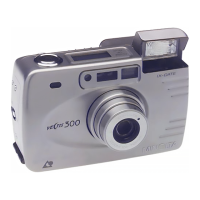
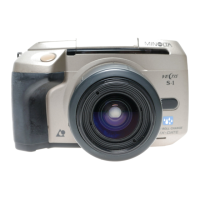
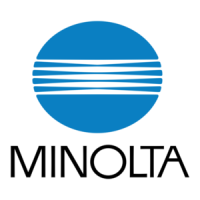

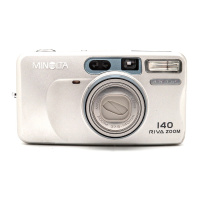
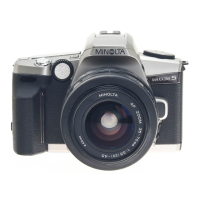

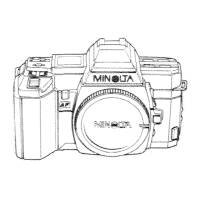
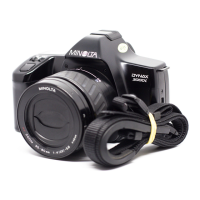
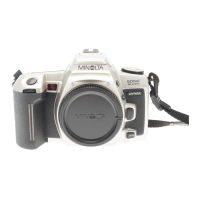
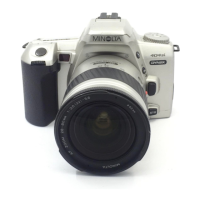
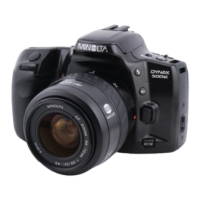
